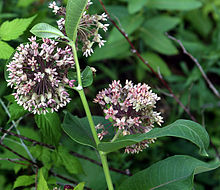|
Milkweed plants
Introduction to milkweed plants[Top] Milkweed is a genus of perennial herbaceous plants which as more than 140 species. Milkweed acquired its name because of its milky juice. The juice contains latex, alkaloids and a variety of complex compounds. Some of the species are toxic.
What is milkweed used for[Top] Milkweed plants have been traditionally used to treat bronchitis and asthma, as an expectorant, a laxative and a diuretic. The sap has been used topically for ringworm, warts and moles. It was used as a contraceptive by some Native Americans. How milkweed is used[Top] Milkweed is available in the form of liquid tincture, fresh, dried, capsule and as a tea.
Science says[Top] Scientists from Australia conducted a study involving thirty six patients with forty eight non melanoma lesions (growth of cancerous cells which are on skin.) Some patients did not respond to surgery or other conventional treatment; others refused surgery or were not suitable for surgery because of their age. The patients were treated for three successive days, once a day by an oncologist. The sap of milkweed was applied with a cotton bud to each lesion. The results were published in the British Journal of Dermatology. The results showed that after one month that 41 out of 48 cancers had disappeared. Those who lesions left were given a second round of treatment.5 months after the treatment two thirds of the 48 cancerous lesions were showing a response. 43% of the patients had no pain after the treatment, 14% had a small amount of pain and one patient had bad short term pain.
Cautions and side effects[Top] Pregnant women should not take milkweed; other possible side effects include vomiting, nausea, lowered blood pressure and decreased heart rate. Return to natural healing home page.
|
Loading



